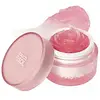What's inside
What's inside
 Key Ingredients
Key Ingredients

 Benefits
Benefits

 Concerns
Concerns

 Ingredients Side-by-side
Ingredients Side-by-side

Water
Skin ConditioningSodium Acrylates Crosspolymer-2
AbsorbentGlycerin
HumectantButylene Glycol
HumectantDipropylene Glycol
Humectant1,2-Hexanediol
Skin ConditioningPEG-40 Hydrogenated Castor Oil
EmulsifyingCaprylyl Glycol
EmollientCarbomer
Emulsion StabilisingTromethamine
BufferingEthylhexylglycerin
Skin ConditioningTheobroma Cacao Extract
Skin ConditioningSodium Hyaluronate
HumectantPrunus Serrulata Flower Extract
Skin ConditioningCaprylic/Capric Triglyceride
MaskingPaeonia Albiflora Flower Extract
TonicDextrin
AbsorbentAlaria Esculenta Extract
Skin ProtectingPseudanabaena Galeata Extract
Skin ConditioningCI 17200
Cosmetic ColorantParfum
MaskingCitronellol
PerfumingHexyl Cinnamal
PerfumingLinalool
PerfumingGeraniol
PerfumingWater, Sodium Acrylates Crosspolymer-2, Glycerin, Butylene Glycol, Dipropylene Glycol, 1,2-Hexanediol, PEG-40 Hydrogenated Castor Oil, Caprylyl Glycol, Carbomer, Tromethamine, Ethylhexylglycerin, Theobroma Cacao Extract, Sodium Hyaluronate, Prunus Serrulata Flower Extract, Caprylic/Capric Triglyceride, Paeonia Albiflora Flower Extract, Dextrin, Alaria Esculenta Extract, Pseudanabaena Galeata Extract, CI 17200, Parfum, Citronellol, Hexyl Cinnamal, Linalool, Geraniol
Water
Skin ConditioningSodium Acrylates Crosspolymer-2
AbsorbentGlycerin
HumectantDimethicone
EmollientButylene Glycol
HumectantDipropylene Glycol
HumectantNiacinamide
Smoothing1,2-Hexanediol
Skin ConditioningDimethicone/Vinyl Dimethicone Crosspolymer
Skin ConditioningAphanizomenon Flos-Aquae Extract
HumectantPyrus Pyrifolia Fruit Extract
EmollientArnica Montana Flower Extract
MaskingChamomilla Recutita Flower Extract
MaskingJasminum Officinale Flower Extract
MaskingHydrolyzed Hyaluronic Acid
HumectantSilica
AbrasiveTocopherol
AntioxidantNelumbo Nucifera Flower Extract
Skin ConditioningFreesia Refracta Extract
Skin ConditioningLeontopodium Alpinum Extract
Skin ConditioningLilium Candidum Bulb Extract
Skin ConditioningNarcissus Pseudonarcissus Flower Extract
Skin ConditioningRosa Damascena Flower Extract
MaskingMethyl Diisopropyl Propionamide
MaskingArginine
MaskingCarbomer
Emulsion StabilisingEthylhexylglycerin
Skin ConditioningC12-14 Alketh-12
EmulsifyingCaprylyl Glycol
EmollientXylitylglucoside
HumectantAnhydroxylitol
HumectantXylitol
HumectantPotassium Sorbate
PreservativeSodium Benzoate
MaskingTin Oxide
AbrasiveCI 77891
Cosmetic ColorantCI 17200
Cosmetic ColorantCI 42090
Cosmetic ColorantWater, Sodium Acrylates Crosspolymer-2, Glycerin, Dimethicone, Butylene Glycol, Dipropylene Glycol, Niacinamide, 1,2-Hexanediol, Dimethicone/Vinyl Dimethicone Crosspolymer, Aphanizomenon Flos-Aquae Extract, Pyrus Pyrifolia Fruit Extract, Arnica Montana Flower Extract, Chamomilla Recutita Flower Extract, Jasminum Officinale Flower Extract, Hydrolyzed Hyaluronic Acid, Silica, Tocopherol, Nelumbo Nucifera Flower Extract, Freesia Refracta Extract, Leontopodium Alpinum Extract, Lilium Candidum Bulb Extract, Narcissus Pseudonarcissus Flower Extract, Rosa Damascena Flower Extract, Methyl Diisopropyl Propionamide, Arginine, Carbomer, Ethylhexylglycerin, C12-14 Alketh-12, Caprylyl Glycol, Xylitylglucoside, Anhydroxylitol, Xylitol, Potassium Sorbate, Sodium Benzoate, Tin Oxide, CI 77891, CI 17200, CI 42090
 Reviews
Reviews

Ingredients Explained
These ingredients are found in both products.
Ingredients higher up in an ingredient list are typically present in a larger amount.
1,2-Hexanediol is a synthetic liquid and another multi-functional powerhouse.
It is a:
- Humectant, drawing moisture into the skin
- Emollient, helping to soften skin
- Solvent, dispersing and stabilizing formulas
- Preservative booster, enhancing the antimicrobial activity of other preservatives
Butylene Glycol (or BG) is used within cosmetic products for a few different reasons:
Overall, Butylene Glycol is a safe and well-rounded ingredient that works well with other ingredients.
Though this ingredient works well with most skin types, some people with sensitive skin may experience a reaction such as allergic rashes, closed comedones, or itchiness.
Learn more about Butylene GlycolCaprylyl Glycol is a humectant and emollient, meaning it attracts and preserves moisture.
It is a common ingredient in many products, especially those designed to hydrate skin. The primary benefits are retaining moisture, skin softening, and promoting a healthy skin barrier.
Though Caprylyl Glycol is an alcohol derived from fatty acids, it is not the kind that can dry out skin.
This ingredient is also used as a preservative to extend the life of products. It has slight antimicrobial properties.
Learn more about Caprylyl GlycolCarbomer is a polymer of acrylic acid. Its main role is to create a gel consistency.
A high amount of carbomer can cause pilling or balling up of products. Don't worry, most products contain 1% or less of carbomer.
Ci 17200 is a synthetic reddish-purple dye.
Dipropylene Glycol is a synthetically created humectant, stabilizer, and solvent.
This ingredient helps:
Dipropylene glycol is technically an alcohol, but it belongs to the glycol family (often considered part of the ‘good’ alcohols). This means it is hydrating and gentle on skin unlike drying solvent alcohols like denatured alcohol.
As a masking agent, Dipropylene Glycol can be used to cover the smell of other ingredients. However, it does not have a scent.
Studies show Dipropylene Glycol is considered safe to use in skincare.
Learn more about Dipropylene GlycolEthylhexylglycerin (we can't pronounce this either) is commonly used as a preservative and skin softener. It is derived from glyceryl.
You might see Ethylhexylglycerin often paired with other preservatives such as phenoxyethanol. Ethylhexylglycerin has been found to increase the effectiveness of these other preservatives.
Glycerin is already naturally found in your skin. It helps moisturize and protect your skin.
A study from 2016 found glycerin to be more effective as a humectant than AHAs and hyaluronic acid.
As a humectant, it helps the skin stay hydrated by pulling moisture to your skin. The low molecular weight of glycerin allows it to pull moisture into the deeper layers of your skin.
Hydrated skin improves your skin barrier; Your skin barrier helps protect against irritants and bacteria.
Glycerin has also been found to have antimicrobial and antiviral properties. Due to these properties, glycerin is often used in wound and burn treatments.
In cosmetics, glycerin is usually derived from plants such as soybean or palm. However, it can also be sourced from animals, such as tallow or animal fat.
This ingredient is organic, colorless, odorless, and non-toxic.
Glycerin is the name for this ingredient in American English. British English uses Glycerol/Glycerine.
Learn more about GlycerinWe don't have a description for Sodium Acrylates Crosspolymer-2 yet.
Water. It's the most common cosmetic ingredient of all. You'll usually see it at the top of ingredient lists, meaning that it makes up the largest part of the product.
So why is it so popular? Water most often acts as a solvent - this means that it helps dissolve other ingredients into the formulation.
You'll also recognize water as that liquid we all need to stay alive. If you see this, drink a glass of water. Stay hydrated!
Learn more about Water